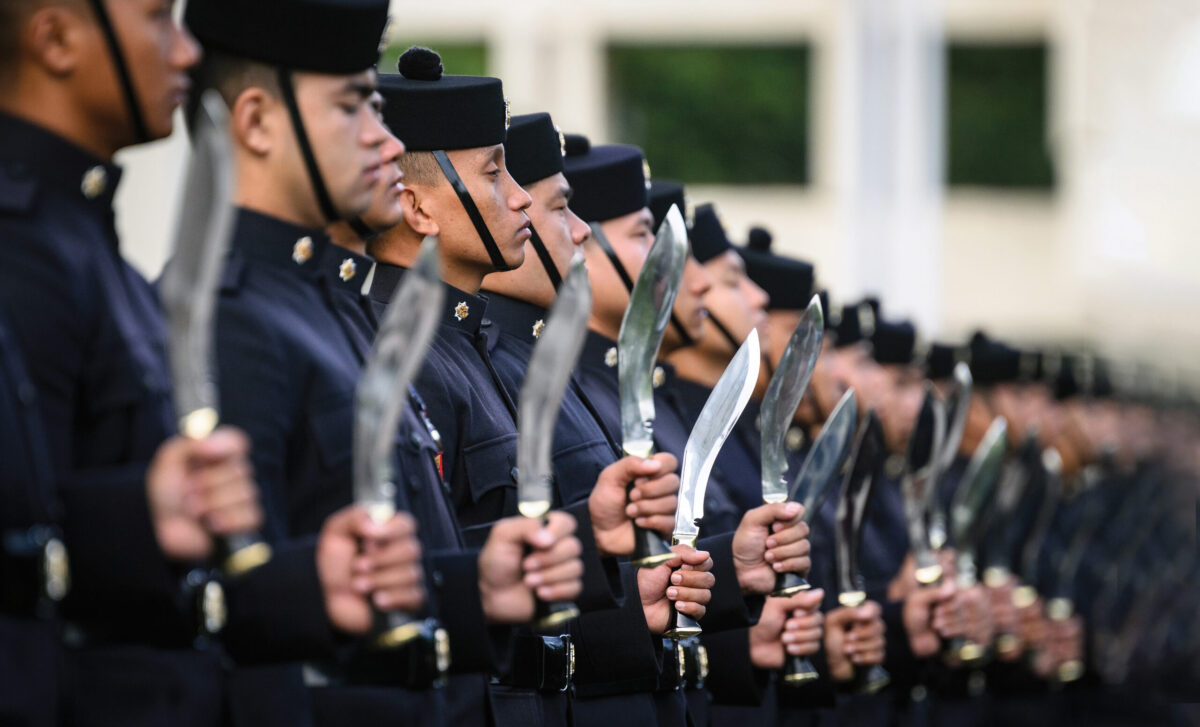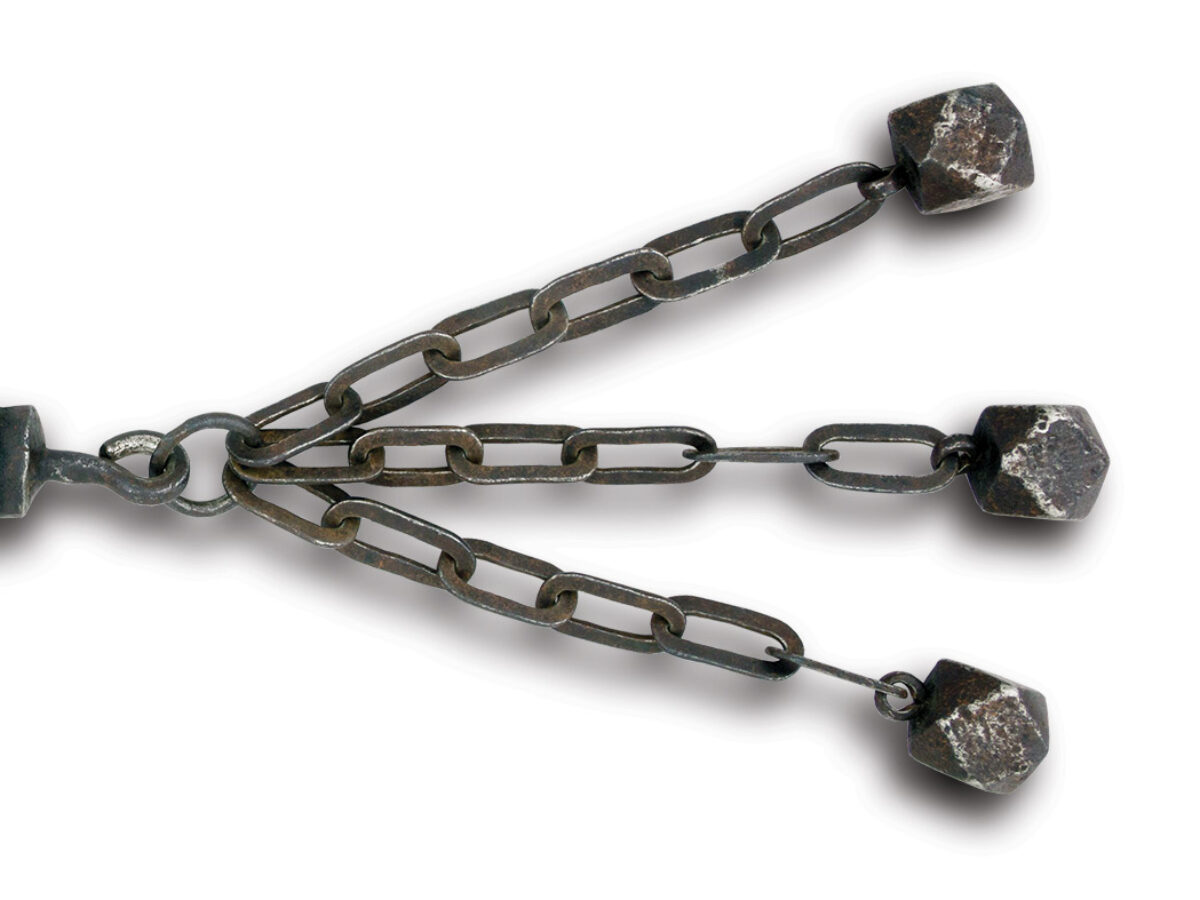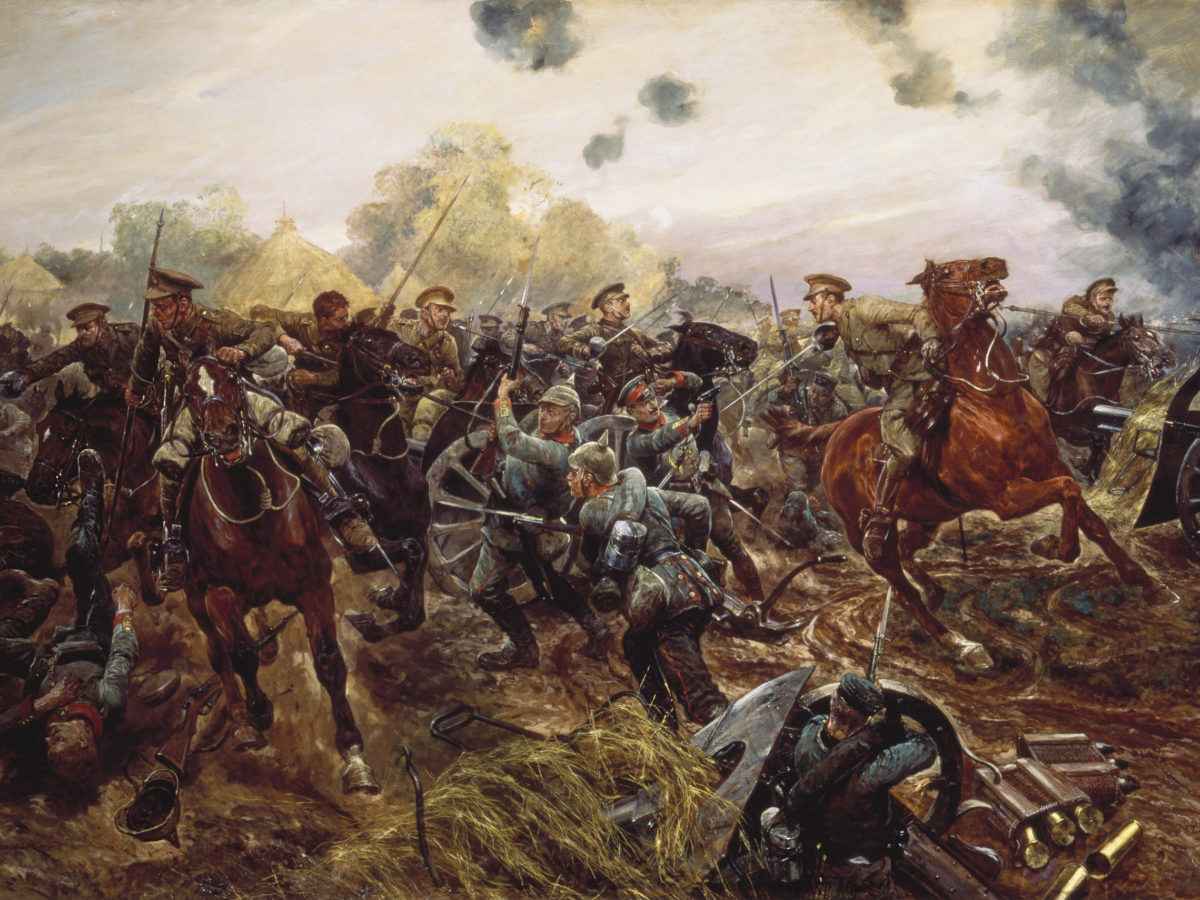The heavy fighting at the Siege of Delhi during the 1857 Indian Mutiny left the 462 men of Maj. Charles Reid’s Sirmoor Battalion with 327 casualties. Despite the carnage, during the fighting Reid, desperate for replacements and hoping to salvage some of his wounded and return them to duty, went to the battalion hospital to look for volunteers. Every one of the wounded who could walk volunteered to rejoin the fighting. In the spring, the Sirmoors moved against the mutineers holding Delhi, overrunning a strong enemy position, capturing 13 guns, and taking the Badli-ki-Serai ridge six miles west of the city. On June 8, joined by two companies of the 60th Rifles, they occupied a house on the southern end of the ridge known as the Hindu Rao’s House where they were immediately attacked.
For the next 16 hours, they fought in the heat and swirling smoke before finally repelling the attackers. They held the ridge and the Hindu Rao’s House for the next three months beating off another 25 attacks. When mutineers came out from behind the stone walls where they had taken cover, the Sirmoor Battalion attacked them. By Sept. 20, it was over. The British had blown open Delhi’s Kashmiri Gate and taken the city.
The Sirmoor Battalion’s 490 men were Gurkhas. By the time the fighting at Badli-ki-Serai ended they were boasting among themselves that the mutineers were offering 10 rupees for the head of a Gurkha, the same price they were paying for an Englishman’s head. Reid wrote in his diary that British authorities who previously had their doubts about the Gurkhas “are now satisfied.”
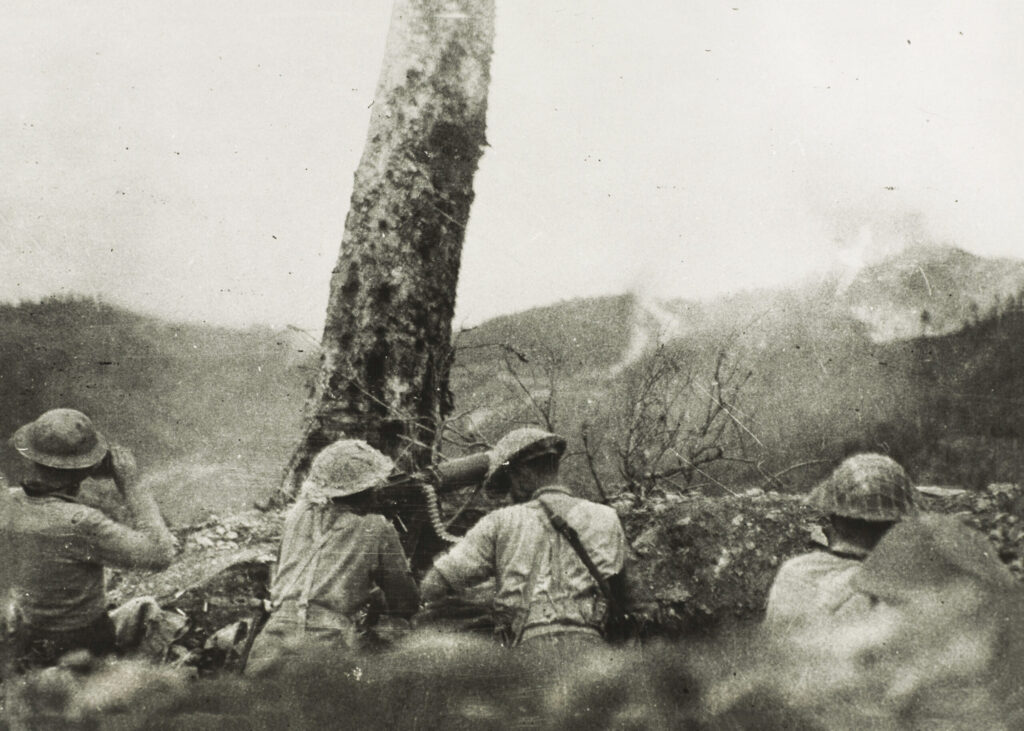
Recommended for you
The Gurkhas have continued to nobly and bravely serve the British Crown until today. Field Marshal William Slim, 1st Viscount Slim who fought alongside them in Burma during World War II called the Gurkha an “ideal infantryman … brave, tough, patient, adaptable, skilled in field-craft, intensely proud of his military record, and unswerving loyalty.” Field Marshal Herbert Kitchener, 1st Earl Kitchener and the hero of British operations in the Sudan called them “some of our bravest” and in his 1930 Gallipoli Diary 1915, Gen. Sir Ian Hamilton, commander in chief of Britain’s Mediterranean Expeditionary Force in World War I wrote that each Gurkha fighter was “worth his full weight in gold at Gallipoli.”
The Legendary Kukri Knife
Over the past 200 years an estimated 200,000 Gurkha fighters have served in Britain’s colonial conflicts, in both World Wars, in the Falkland Islands, the Middle East, and Afghanistan with 46,000 of them living up to the Gurkha motto: “Better to die than be a coward.”
These fighters from the mountains of Nepal average about 5 foot 3 inches tall, diminutive by European and American standards, but for centuries the image of charging Gurkhas, waving their kukri knives, and shouting their battle cry of “Aayo Gurkhali” (“The Gurkhas have arrived!”)have emboldened their allies and terrorized their enemies. The kukri alone is terrifying and well known.
These distinctive knives—the Gurkha emblem is two crossed kukris, with a crown above them—have been employed by the Gurkhas for centuries and may have evolved from the Greek kopis, the single-edged curved swords carried by Alexander the Great’s cavalry when it entered northern India in the fourth century bce. Basically a chopping weapon, the kukri is up to 18 inches long, weighs between one and two pounds, and is curved downward with a roughly quarter-inch spine tapering to a point.
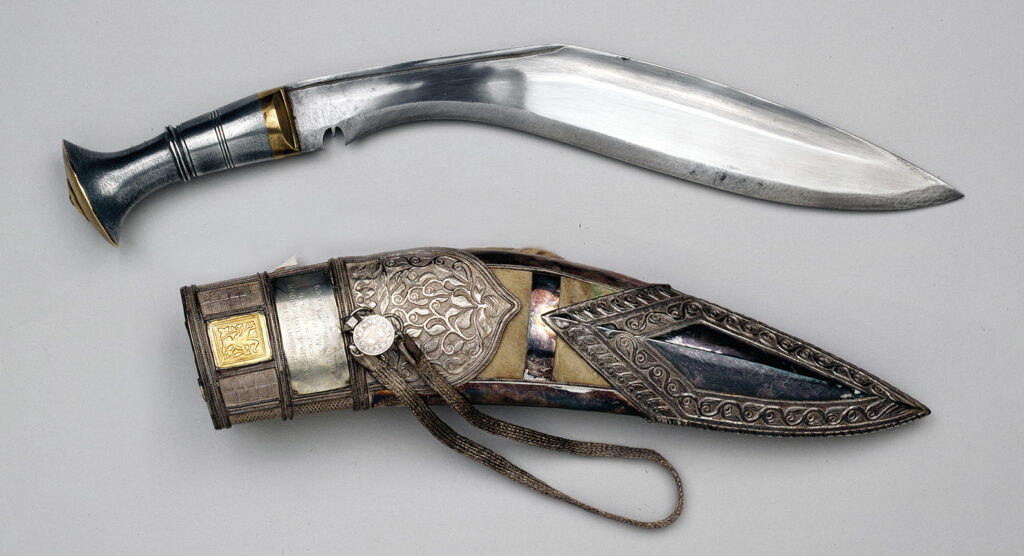
The widest portion of the kukri blade is in the front portion of the blade, between the tip and where the downward curvature begins. This “well-forward” blade weighting adds substantial power to the downward thrusting motion, greatly increasing the blade’s penetration when slicing through a target—such as an unlucky enemy soldier!
Generally, there is a notch in the blade just below the handle that is there for multiple reasons: symbolic; religious; and practical. For one, that simple notch allows blood to drain away, rather than coat the kukri’s handle making it slippery. Military issue kukris typically come with two much-smaller wooden-handled bladed knives contained in their own separate sheaths integrated into the main sheath: a karda utility knife; and a chakmak sharpening tool. The kukri’s handle is usually made of hardwood, but other substances such as buffalo horn, metal, and even ivory have been used. The Gurkha kukri is sheathed in a leather-wrapped wooden scabbard.
Legend has it that once a kukri has been unsheathed it must “taste blood” before it can again be sheathed. In truth, however, the kukri serves both as a weapon and a general utility knife used by the Gurkhas for cooking and various camp tasks.
All Gurkha fighters are trained in its use for hand-to-hand combat. Stories have circulated for centuries about the kukri’s fierceness and effectiveness including one from a Gurkha unit fighting in North Africa during World War II that reported enemy losses of 10 killed and “ammunition expenditure nil,” a mute acknowledgement of the kukri’s effectiveness.
During the Falklands War in the 1980s, a photograph of a Gurkha sharpening his kukri circulated and was said to have unsettled Argentinians troops to such an extent that members of the 1st Battalion 7th Duke of Edinburgh’s Own Gurkha Rifles captured several heavily armed Argentine combatants by doing little more than brandishing their kukris.
Military Tribes
There is “no agreement as to who is and who is not a Gurkha,” Byron Farwell wrote in his 1984 book, The Gurkhas. “There are some who would call all Nepalese ‘Gurkhas’ regardless of their origin, tribe, or social class. Others would limit the term to those who live in the hills around the town of Gurkha, some twenty-five miles northwest of Kathmandu.”
What is accepted is that the Gurkha fighters come from the mountains of Nepal (and parts of northeast India) and generally from four of what Great Britain has traditionally called that country’s “military tribes” that inhabit the region: Magars; Gurungs; and to a lesser extent, Limbus and Rais.
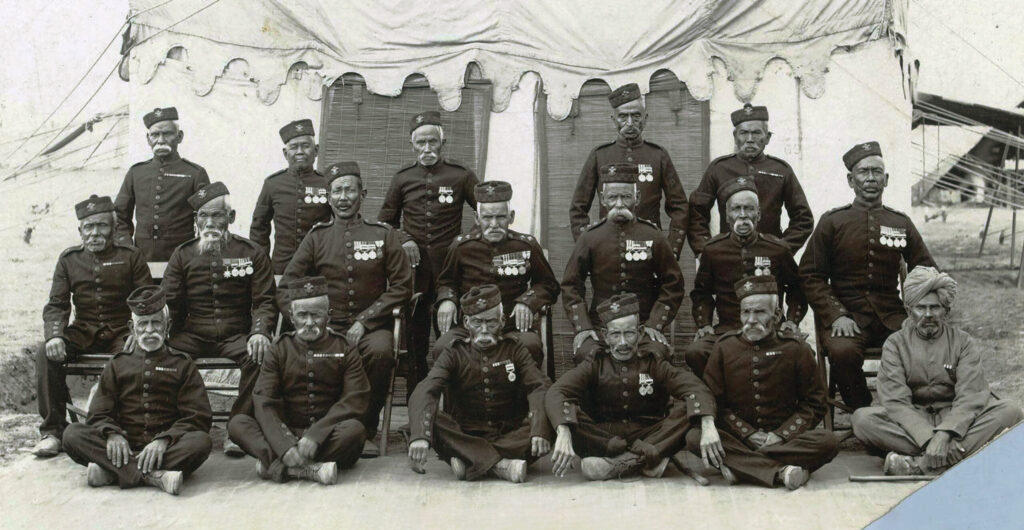
Nepal, today a country of about 30 million people, has been settled for at least 2,500 years. Venetian traveler Marco Polo passed through there in the 13th century calling it “wild and mountainous.” It is also the legendary birthplace of Gautama Buddha, born at Lumbini in what is today southern Nepal. Most of the area’s history is filled with war rather than the Buddha’s peace and serenity. It is a history of battle and betrayal; tribes, individuals, and various sections fought for supremacy. It is a martial history.
When Great Britain’s East India Company, formed in 1600 to “exploit” trade with eastern and southeast eastern Asia and India, moved men and supplies into India and Nepal in the early 19th century, Gurkha tribesman from the north harassed them. These skirmishes led to a May 29, 1814, raid by tribesman on three British police stations that killed twenty people including one Englishman and led to the Anglo-Nepalese War of 1814-1816. The British retaliated with separate invasions of Nepal in 1814, 1815, and 1816. The tribesman repelled the first two expeditions but were defeated in 1816 at Malaom in northeast India.
An Unlikely Alliance
In the process, however, the British had become impressed with the fighting ability of the Nepalese. John Ship of the 87th Foot, who fought them in the 1814 campaign, wrote about the tribesmen that, “I never saw more steadiness or bravery exhibited in my life. Run they would not, and of death they seemed to have no fear though their comrades were falling thick around them, for we were so near that every shot told.”
Farwell also tells that during the Anglo-Nepalese War “in the middle of a British bombardment a Gurkha came out of the fort [at Kalunga] and approached the British line waving his hands; the first surrender the British thought. A cease-fire was ordered, and he was welcomed into the lines. His lower jaw was shattered and he was happy to be patched up by the surgeons, but this done, he asked permission to return to the fort and continue the fight”—an attitude more appropriate to a soccer game than a war.
India’s Governor General (1813-1823) Francis Rawdon-Hastings, 1st Marquess of Hastings, authorized the establishment of the first Gurkha regiment, the Sirmoor Battalion, in April 1815 under the command of Lt. Frederick Young of the East India Company, who would command the Sirmoor Battalion for the next 28 years. (It first saw action in 1817 during Britain’s 3rd Mahratta War). After the signing of the Treaty of Segauli in 1816, which formally ended the Anglo-Nepalese War, the East India Company began recruiting other Gurkha regiments to serve as British mercenaries.
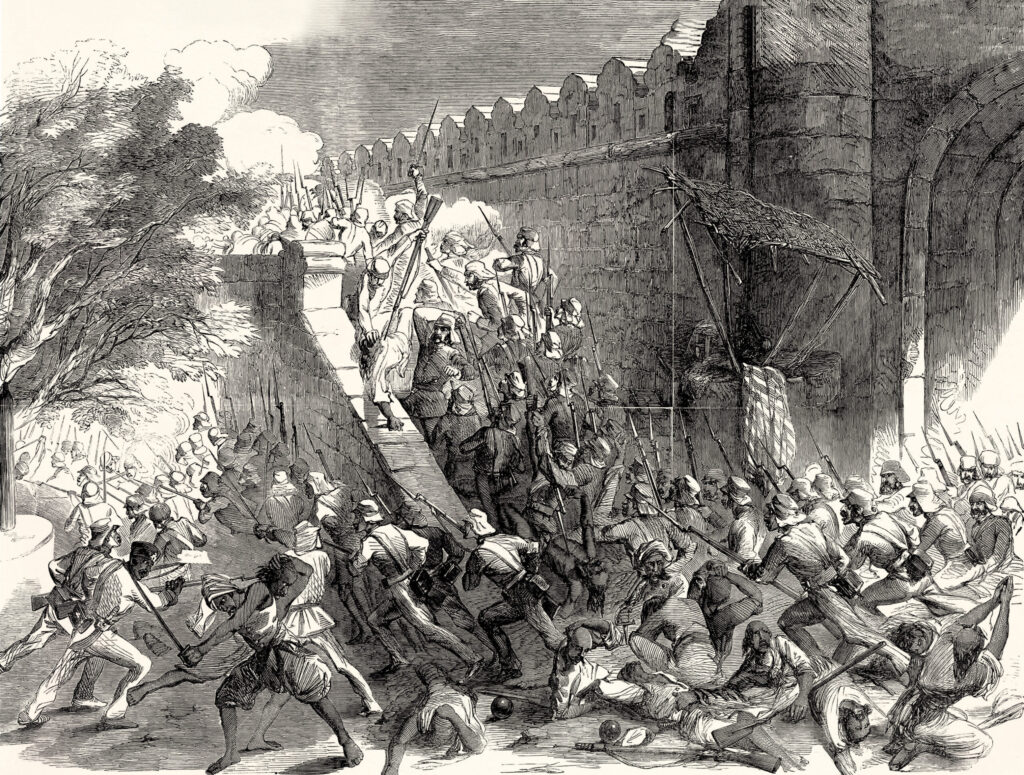
The war left both the English and the Gurkhas with an increased respect or each other. The British erected two obelisks at Kalunga, the location of a hill fort Gurkhas had defended in November 1814. One obelisk commended the bravery of the British who had fought there and the other the courage of the fort’s Gurkha defenders.
Regardless of the reputation the Gurkha fighters had earned, the English still considered them to be “sepoys”—a slightly disparaging term applied to all the native soldiers the Crown employed, and the respect the Gurkhas had earned was a respect qualified with caution.
The Indian Mutiny changed that. The Mutiny, a generalized rebellion of local Indian troops against British rule broke out in 1857 in northern India, spread like a wildfire, and quickly became centered around the city of Delhi, where what has come to be called the Siege of Delhi began in June 1857. It would last for the next four months. During the fighting, the British still distrusted their Gurkha regiments’ loyalty; British commanders often stationed Gurkha troops close to the British artillery so that artillery could be turned against the Gurkhas at any sign of disloyalty. Such an action was never required. By the end of the of the Mutiny in July 1859, Gurkhas had established their loyalty, and British authority, as Reid wrote, had been “satisfied.”
“The British began to take a serious and studied view of the Gurkhas [and] to regard them as something more than good ‘native infantry,’ but as something special,” Farwell wrote. “In an era when British regiments of the line were filled with society’s rejects and it was felt that fierce discipline was required to keep the men under control, Gurkhas were enthusiastic soldiers requiring little discipline.”
In one seven-year period, he wrote, only one Gurkha faced a court martial. “No British battalion could make such a boast, and probably such a record could not be duplicated by any battalion in any European or American army,” he wrote. (Meanwhile, the East India Company had deteriorated and after 1834 was little more than the manager of British government of India. It ceased to exist in 1873).
From World War I to Today
Gurkhas fought in the Britain’s colonial wars including the Sikh Wars of 1845-46 and 1848-49, the three Burma Wars of 1824-26, 1852, and 1885, the Afghan wars of 1839-42, 1878-81, and 1919. They also took part in the expedition led by Maj. Francis Younghusband into Tibet in 1903-04.
In World War I, more than 50,000 Gurkhas fought in Gurkha regiments (as well as 16,544 Gurkhas who served in the regular Indian Army), suffered 20,000 casualties and received 2,000 individual awards for bravery, including two Victoria Crosses. (A third VC was won by a British commander of a Gurkha unit). Nothing in their history, David Bolt wrote in his 1967 book Gurkhas, “prepared [the Gurkha force] for the conditions under which it was called upon to fight in Flanders: the sodden chill of a European winter, with its full-scale artillery barrages and acceptance of mass casualties, and the murderous hazard of occupying trenches dug previously by the much taller British soldiers so they could not see over the parapets.”
British general Sir James Willcocks, who commanded the Indian Corps in France in 1914, pointed out that the Gurkha regiments also fought without hand grenades or mortars, were “exposed to every form of terror, and they could reply only with their valor and their rifles and the two machine-guns per battalion with which they were armed, and yet they did it.”
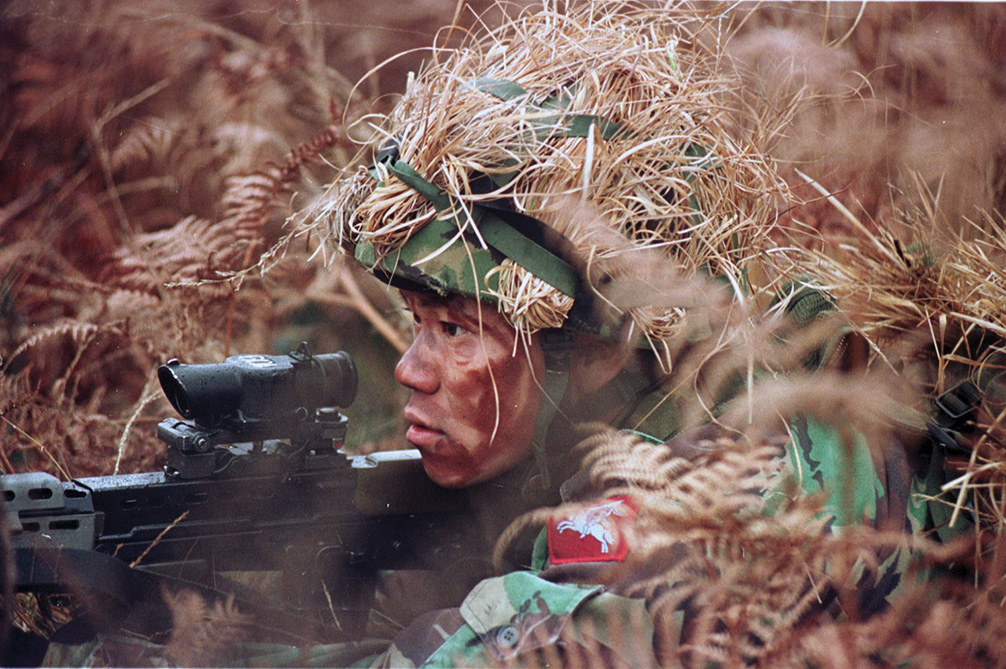
They fought at the Loos, where Gurkhas kept fighting to the last man, at Givenchy, and Neuve-Chapelle in France, at Ypres, as well as in Mesopotamia, Persia, Palestine, and at Gallipoli where Gurkha fighters captured a heavily guarded Turkish position by climbing a 300-foot-high bluff under cover of a bombardment. Gurkha troops served with T.E. Lawrence, the famous Lawrence of Arabia, on the Arabian Peninsula.
Yet despite their recognized courage and loyalty during these years, it was only in 1911 that Gurkhas became eligible for Britain’s highest military honor, the Victoria Cross.
Since then, individual Gurkha fighters have won 26 VC’s including the two won during World War I. One of those two VC’s went to 26-year-old Rifleman Kulbir Thapa of the 2nd Battalion, 3rd Queen Alexandra’s Gurkha Rifles for his rescue of wounded men during the fighting at Fauquissart, France, in September 1915. He found a wounded man behind the first line of German trenches and stayed with him until the next morning when he dragged him through the German barbed wire in what has been called “spitting distance” of German troops.
Leaving him at the Allied lines, Thapa returned and brought in two other wounded, and in full daylight went back yet again to carry out a wounded British soldier. He was the first Gurkha to win a VC. (The first Indian enlisted man to receive a VC was Darwan Singh Negi of the 39th Garhwal Rifles of the Indian Army for his bravery in clearing a trench near Festubert, France). The second Gurkha to win a VC in World War I was Karanbahadur Rana, also of the 3rd Queen Alexandra’s Gurkha Rifles, who won his award at El Kefr, Palestine in 1918 for taking an enemy machine gun while under heavy fire.
The Gurkhas’ reputation as fighters expanded even more during World War II. During that conflict, over 110,000 served in 40 Gurkha battalions in Africa, Italy, Greece, and Southeast Asia. In all 30,000 of them were killed or wounded, and 12 Gurkha fighters won Victoria Crosses including 19-year-old anti-tank gunner Ganju Lama of the 1st Battalion, 7th Gurkha Rifles. Though wounded in the leg and arm and with his wrist broken, he crawled through a Japanese crossfire in Burma (now Myanmar) to destroy two enemy tanks.
The incident occurred only three weeks after Lama had won the British Military Medal, a forerunner of the Military Cross, for taking out a Japanese tank in a similar situation. Sgt. Gaje Ghale of the 5th Royal Gurkha Rifles suffered leg, arm, and upper body wounds but still engaged in hand-to-hand combat with Japanese defenders, overran a Japanese position and then repelled a counterattack.
Tul Bahadur Pun, armed with a Bren gun, singlehandedly overran a Japanese position under heavy fire, killing three of its defenders and putting five others to flight. Havildar Manbahadur, was shot in the spleen and slashed in the back of the head by a Japanese officer’s sword, but survived—and walked 60 miles to rejoin his unit and seek medical attention.
The Royal Gurkha Rifles
In 1947, when Independence was granted to India, 10 Gurkha Regiments existed. Six remained in the Indian Army and four transferred to the British Army, the 2nd King Edward VII’s Own Gurkha Rifles (The Sirmoor Rifles), and the 6th, 7th and 10th Gurkha Rifles. They served in the Falklands, Cyprus, Bosnia, Southeast Asia, and today in the Middle East and Afghanistan. (Under Article 47 of the Geneva Convention, Britain’s Gurkha fighters—like fighters in the French Foreign Legion—are not considered mercenaries but as regular British infantry units receiving regular pay and treatment while serving a stated enlistment period).
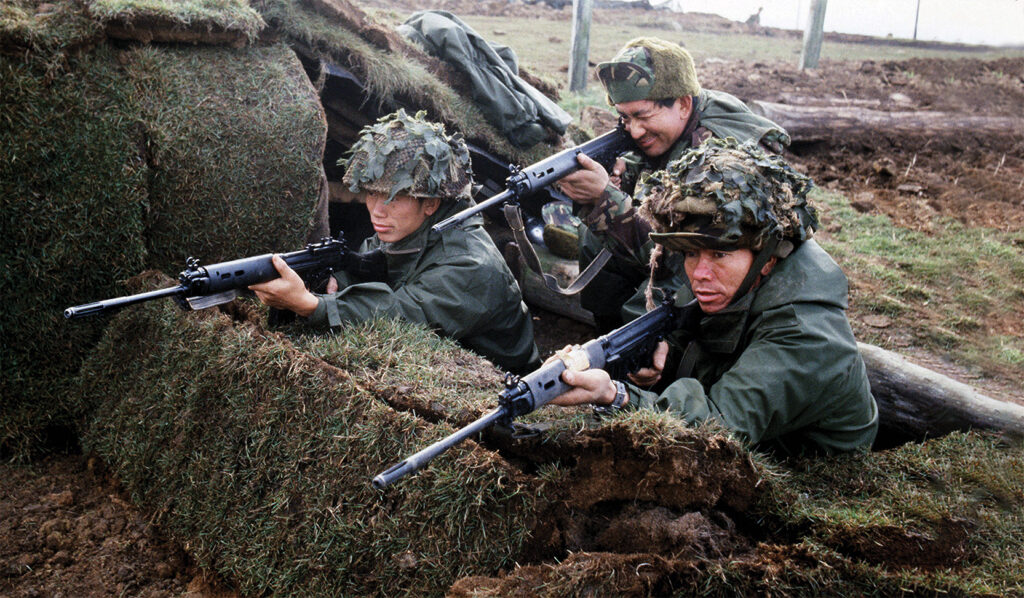
In 1994, these four regiments were merged into one unit, the Royal Gurkha Rifles, as part of the Brigade of Gurkhas of the British Army and Britain’s only Gurkha infantry regiment.
There are currently about 3,000 fighters in the Gurkha Brigade and competition for any openings is fierce. In 2019, for example, 10,000 young Nepalese signed up to compete for about 500 openings. To be considered, these young Nepalese men—and women beginning in 2020— from the rural and largely impoverished mountains must pass one of the world’s most grueling military selection processes, which includes completing a three-mile, uphill run with a 55-pound pack that must be completed in 45 minutes and doing 70 sit-ups in two minutes. Both men and women applicants face the same qualification test. To apply they must also be at least 5 foot 1 inch tall and weigh at least 110 pounds.
During May of the late Queen Elizabeth II’s 2022 Platinum Jubilee year, the Queen’s Own Gurkha Logistic Regiment was responsible for guarding the monarch and Gurkha guards stood at attention at Buckingham Palace, St James’ Palace, Windsor Castle, and the Tower of London. Gurkhas also marched in her funeral procession four months later.
Aayo Gurkhali.

